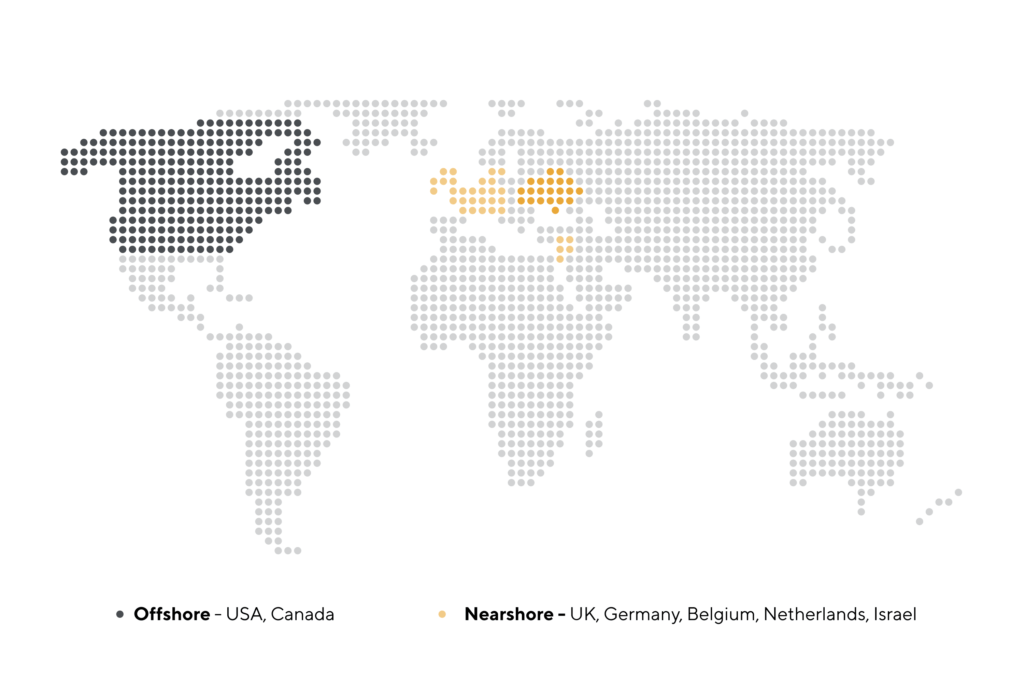When getting software developed, you need an agency that will deliver. A reliable agency, a partner in technology, and one that’s going to work well with your processes, team and values.
As part of picking the right web development partner, you might wonder whether to offshore or nearshore this work? Another option is to onshore the work, which means picking an agency in your home country, or very close to home.
But compared to the offshore or nearshore options, onshore software development is often prohibitively expensive. At the same time, it rarely offers any appreciable benefits compared to offshore development, or working with a nearshore team.
Around the world, there are several regions known for software development. Whether they’re offshore or nearshore, in many ways, depends on where you’re based. To a company in Europe, Mexico and Latin America would be offshore – some distance from the client. Whereas, to a company in the UK, working with a software company in Ukraine would count as a nearshore development partner.
The regions of the world where many companies outsource software work to include Mexico and Latin America, Central & Eastern Europe, the Middle East (Israel in particular), India, South East Asia, and China. For the purposes of this article, we will focus on nearshore development in Central & Eastern Europe (CEE), in comparison to offshore development further afield.
What does offshore development mean?
For companies in Europe, the UK or US, to send work offshore usually means to outsource it hundreds or thousands of miles away. Some of the most popular regions for outsourcing include Mexico, the Philippines and Latin America (for US companies), Central & Eastern Europe (CEE; for European and UK companies), alongside India, South East Asia, and China.
Israel is another popular option, especially for large tech companies, or big corporations that benefit from opening an R&D office. In the case of Israel, these offices are usually in-house departments, so aren’t classed as offshoring.
Whether or not development work is going offshore depends on geography. For US companies, Mexico counts are nearshore development work, due to its proximity. For European countries, including the UK, the CEE region is a nearshore development; again because of geographic proximity. Both regions, for companies in the UK, EU and US come with the same upsides as nearshore development; although there are numerous upsides for US clients for working with partners in Central & Eastern Europe, even with the time difference.

Picture 1. Offshore software development.
Businesses usually send offshore development work to regions such as India, or South East Asia, for the perceived cost savings. Hourly rates, and therefore overall project rates can be lower. But not as low as they used to be, and these savings are offset by downsides.
However, there are several downsides when it comes to offshoring to lower cost regions. Time Zone differences and language barriers can often cause delays and problems with projects. When software is getting developed, the last thing clients need is misunderstandings slowing down the process, contributing to mistakes, and making the project cost more.
A time difference that’s too vast also means it’s difficult for a client and development team to communicate in real-time. Although that shouldn’t be essential every day, it does help to keep a project moving forward in the right way. It reduces misunderstandings, makes projects run more efficiently, and ensures that an external development team is an extension of your in-house teams.
What is nearshore development?
On the other hand, nearshore development is about working with software companies closer to where you are based. For example, a company in London could work with a nearshore development partner in Ukraine.

Picture 2. Nearshore software development.
Nearshore development ensures the software engineers working on a project are only an hour or two from the client, which is usually the case between European or UK companies and those in the CEE region.
For clients, this means projects are more cost effective than working with developers in their own countries, without worrying about language or time zone differences, or compromising on quality. A smaller time zone difference makes it easier to communicate in real-time. When software teams are working together, this ensures projects run far smoother, reducing misunderstandings and mistakes.

Picture 3. Nearshore and offshore destinations we are working with.
How to choose the best option?
What’s best for your company partly depends on where you are. For UK and European companies, the CEE region is closer, making nearshore development a smart strategic option. Even for US businesses, outsourcing to the CEE region, although it’s further than Mexico and Latin America, often proves the smart choice.
Nearshore software development in the CEE region, particularly Ukraine benefit from the following:
- Minimal time zone differences, increasing the opportunity for real-time communications;
- No language barriers. Most developers and those in client-facing roles speak excellent English;
- High-quality development work, and quality assurance throughout; although this depends on the provider you work with, and benefits from extensive technical focus in colleges and universities across the region;
- Cost-effective, compared to working with onshore teams, and the communications and quality advantage often means projects are delivered more cost effectively than offshore teams can manage.
How to manage your offshore partner?
Managing a nearshore or offshore partner, depending on where you’re based, depends on picking the right one to start with. Select a technology partner you can trust, and rely on from start to finish.
Have a plan for the project to start with. Assess potential partners based on work they’ve done, reviews, case studies, and examples of other projects they’ve delivered for clients. Sector knowledge and expertise is useful too, as is an overview of the technology the team are familiar with.
Once you’ve selected a technology partner, ensure your processes and systems are aligned. Especially if you’ve got an in-house development team working with them. Ensure everyone is on the same page. Keep communication open and flowing smoothly.
LaSoft: Your web and mobile development agency. We are a technology partner you can trust. Get more information today. LaSoft provides a wide range of services, including web and mobile development, product design, management and quality assurance.


